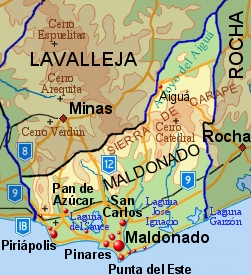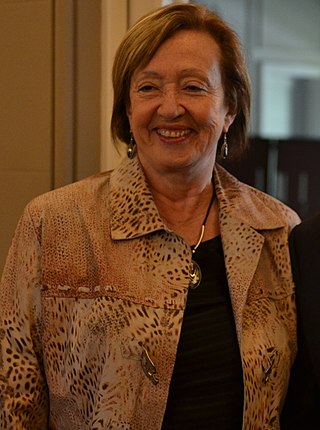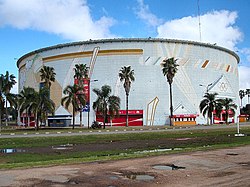
Montevideo is the capital and largest city of Uruguay. According to the 2011 census, the city proper has a population of 1,319,108 in an area of 201 square kilometers (78 sq mi). Montevideo is situated on the southern coast of the country, on the northeastern bank of the Río de la Plata.

The Maldonado Department, with an area of 4,793 km2 (1,851 sq mi) and 164,300 inhabitants (2011), is located to the southeast of Uruguay. Its capital is Maldonado.
The Departamento de Canelones is one of the 19 Uruguayan departments. With an area of 4,536 km2 (1,751 sq mi) and 518,154 inhabitants, it is located in the south of Uruguay. Its capital is Canelones. Ciudad de la Costa is the largest city by total population and Las Piedras is the largest city with an official census.

Plaza Independencia is the most important city square in Montevideo, Uruguay, laid out in the 19th century in the area occupied by the Citadel of Montevideo. In its center is a monument to General José Gervasio Artigas, and below it, his mausoleum.

Channel 10 is a Uruguayan free-to-air television network based in Montevideo. It began its transmission in 1956 as the first television broadcaster in the country and the fourth in Latin America. Its owned and operated by Sociedad Anónima Emisora de Emisión Televisión y Anexos. The network's headquarters are in the Palermo neighbourhood.

Barrio Sur is a barrio of Montevideo, Uruguay. It borders Ciudad Vieja to the west, the central business district to the north, Palermo to the east and the coastline to the south.

Santiago Vázquez is a village at the western limits of Montevideo Department in Uruguay.
La Paz is a small city in the Canelones Department, southern Uruguay.

Plaza de Cagancha is a public square in barrio Centro of Montevideo, Uruguay. Located on 18 de Julio Avenue, the main avenue of the city, it originated in 1836 as the central space of the layout of the "Ciudad Nueva", outside the limits of the walled area of the colonial period.

Parque Lecocq is a nature reserve northwest of Montevideo, Uruguay, near the town of Santiago Vázquez. It houses mammals and birds and protects flora and pursues/supports breeding programs. It is adjacent to protected wetlands.

The Piria Palace is the headquarters of the Supreme Court of Uruguay. Located on the south side of the Plaza de Cagancha in Montevideo, on the Human Rights Passage, it was declared a National Historical Monument in 1975. In front of its main entrance is the Monument to Justice, a work by Rafael Lorente Mourelle.

Francisco Carlos Bustillo Bonasso is a Uruguayan diplomat who served as Minister of Foreign Relations of Uruguay from July 6, 2020 to November 1, 2023.
Verdad ('Truth') was a short-lived daily tabloid newspaper published in Montevideo, Uruguay, published in the early 1950s as an organ of the Communist Party of Uruguay. The publication was launched in late August 1950, in the run-up to the general election held in that year.

María Julia Muñoz is a Uruguayan doctor in medicine and politician. She served as Minister of Public Health from 2005 to 2010 and as Minister of Education and Culture between 2015 and 2020.

The Antel Arena is a multipurpose indoor arena that is located in the neighborhood of Villa Española, Montevideo, Uruguay. The arena has a capacity of 15,000 people for concerts, and 10,000 people for basketball games.

María Laura Raffo Degeronimi is a Uruguayan economist, businesswoman, and politician of the National Party. She began her political career in 2020 after being proclaimed as the candidate of the Coalición Multicolor for the municipal elections of that year.

Karina Pankievich is a Uruguayan trans rights activist. She is the president of Trans Association of Uruguay.
The COVID-19 pandemic in Uruguay has resulted in 1,041,682 confirmed cases of COVID-19 and 7,686 deaths.

Julio Daniel Salinas Grecco is a Uruguayan neurologist and politician of Open Cabildo (CA), who served as Minister of Public Health of Uruguay from 1 March 2020 to 13 March 2023.
















